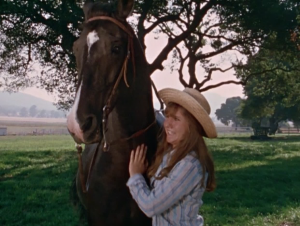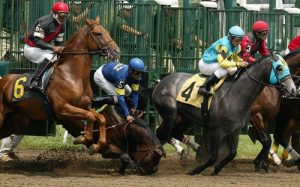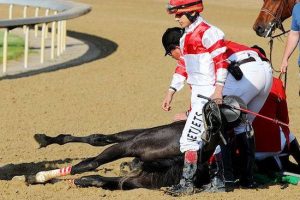 In a 1974 episode of “Shazam,” I played a girl determined to save the life of a horse sentenced to die by an evil and heartless man. The lesson of the story was that all life has meaning and that living beings are entitled to justice and mercy. Between shows like “Shazam” and all those westerns, I worked with a lot of horses. I know them to be beautiful, gentle, and intelligent animals, which is why horse racing makes me both sad and angry, and why I’ve written this brief essay.
In a 1974 episode of “Shazam,” I played a girl determined to save the life of a horse sentenced to die by an evil and heartless man. The lesson of the story was that all life has meaning and that living beings are entitled to justice and mercy. Between shows like “Shazam” and all those westerns, I worked with a lot of horses. I know them to be beautiful, gentle, and intelligent animals, which is why horse racing makes me both sad and angry, and why I’ve written this brief essay.
They perform for our entertainment behind a glamorous façade of fancy dress, cocktails, floral wreaths, and glittering trophies. At weights greater than 1,000 pounds, they are supported by ankles no bigger than those of a human. Carrying 126 pounds of jockey and tack on their slender backs, they are whipped and forced to race with blinkered vision at speeds over 30 miles an hour on tracks of cement-hard dirt, slippery turf, or sometimes thick, spattering mud. They are the victims of a multi-billion-dollar industry rife with drug abuse, catastrophic injuries, and race fixing, and many will end their days at the slaughterhouse. They are racehorses.
 Today is the running of the 142nd Preakness Stakes, the second leg of the celebrated Triple Crown of horse racing. Millions of dollars will change hands at Pimlico Race Course in Baltimore, where this week a two-year-old horse was killed after breaking his leg in a race, marking the second time in three years a horse was killed on the track at Pimlico during Preakness week.
Today is the running of the 142nd Preakness Stakes, the second leg of the celebrated Triple Crown of horse racing. Millions of dollars will change hands at Pimlico Race Course in Baltimore, where this week a two-year-old horse was killed after breaking his leg in a race, marking the second time in three years a horse was killed on the track at Pimlico during Preakness week.
On one recent Preakness Day, five horses took to starting gates across the United States for their final races. One died of a heart attack, while three others were killed after fracturing legs; another suffered a fatal injury falling over a jump in a steeplechase race. In 2015, 953 horses lost their lives on racetracks across the United States, meaning every day of the year we are killing two or three horses for two-dollar bets.
 Many racehorses are doped and drugged. Trainers and veterinarians keep injured horses racing when they should be healing by giving them a variety of legal drugs to mask pain and control inflammation. Running with pain dulled by drugs leads to breakdowns, further injuries, and often death.
Many racehorses are doped and drugged. Trainers and veterinarians keep injured horses racing when they should be healing by giving them a variety of legal drugs to mask pain and control inflammation. Running with pain dulled by drugs leads to breakdowns, further injuries, and often death.
Not all drugs used are legal. “There are trainers pumping horses full of illegal drugs every day,” says a former Churchill Downs public relations director. “With so much money on the line, people will do anything to make their horses run faster.” One trainer was suspended for “treating” five horses with a drug similar to Ecstasy, and another was banned from racetracks for using the stimulant clenbuterol.
 Few injured or aged horses or those not fast enough to finish “in the money” are retired to pasture, because owners don’t want to feed and stable a horse who doesn’t pay for his or her upkeep. Many of those horses are sold to slaughterhouses in Canada, Mexico, or Japan, where they are killed and processed into dog food and glue. Their flesh is also exported to countries such as France and Japan, where horse meat is considered a delicacy. Horses sent to slaughter spend their last days in cramped trailers with no access to food or water. Injuries during transport are common. Upon arrival they are herded into corrals where they thrash about in fear and panic to avoid the shot of the captive-bolt gun intended to render them unconscious before their throats are cut. It’s a sad and horrifying end to the life of such a beautiful and majestic animal.
Few injured or aged horses or those not fast enough to finish “in the money” are retired to pasture, because owners don’t want to feed and stable a horse who doesn’t pay for his or her upkeep. Many of those horses are sold to slaughterhouses in Canada, Mexico, or Japan, where they are killed and processed into dog food and glue. Their flesh is also exported to countries such as France and Japan, where horse meat is considered a delicacy. Horses sent to slaughter spend their last days in cramped trailers with no access to food or water. Injuries during transport are common. Upon arrival they are herded into corrals where they thrash about in fear and panic to avoid the shot of the captive-bolt gun intended to render them unconscious before their throats are cut. It’s a sad and horrifying end to the life of such a beautiful and majestic animal.
Please join me in opposition to horse racing by refusing to attend or bet on races and by lobbying against the construction of new racetracks.
Peace for ALL the animals with whom we share the planet!
